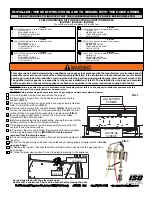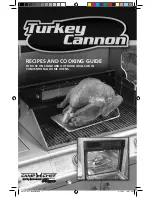
21
Useful Charts and Information
VENTILATION REQUIREMENTS
It is very important that sufficient air for combustion
and ventilation is provided to the room containing the
appliance, to enable correct and efficient working of the
appliance and chimney system. Reference should be
made to the appliance manufacturer’s instructions and
recommendations are also given in the Building Regulations
Document J, see below:
The carbon monoxide alarms should comply with BS EN
50291:2001.
The carbon monoxide alarm must be located in the same
room as the appliance:
a) On the ceiling at least 300mm from any wall or if it is
located on a wall, as high up as possible (above any doors
and windows), but not within 150mm of the ceiling and
b) between 1m and 3m horizontally from the appliance.
N.B Provision of a carbon monoxide alarm should not
be regarded as a substitute for correct installation and
regular servicing.
CARBON MONOXIDE ALARMS
Where a new or replacement fixed solid fuel appliance
is installed in a dwelling, a carbon monoxide alarm should
be provided in the room where the appliance is located.
VENTILATION REQUIREMENTS FOR SOLID FUEL
Type of Appliance
Notes:
Open appliance, such as an open fire with no throat, e.g. a
fire under a canopy as in Diagram 23.
Open appliance, such as an open fire with a throat, as in
Diagrams 22 and 29.
Other appliance, such as a stove, cooker or boiler, with a flue
draught stabiliser.
1. Equivalent area is as measured according to the method in BS EN 13141-1:2004 or estimated according to paragraph 1.14.
Divide the area given in mm
2
by 100 to find the corresponding area in cm
2
.
2. For simple open fires as depicted in Diagram 29, the requirement can be met with room ventilation areas as follows:
3. Example: an appliance with a flue draught stabiliser and a rated output of 7kW would require an equivalent area of (5 x 300)
+ (2 x 850) = 3200mm
2
4. It is unlikely that a dwelling constructed prior to 2008 will have an air permeability of less than 5.0m
3
/h.m
2
) at 50Pa unless
extensive measures have been taken to improve air-tightness. See Appendix F.
Other appliance, such as a stove, cooker or boiler, with no
flue draught stabiliser.
Permanently open air vent(s) with a total equivalent area of
at least 50% of the cross sectional area of the flue.
Permanently open air vent(s) with a total equivalent area of
at least 50% of the throat opening area. (2)
Permanently open air vents as below:
If design air permeability > 5.0m
3
/(h.m
2
) then
300mm
2
/kW for first 5kW of appliance rated output
850mm
2
/kW for balance of appliance rated output
If design air permeability
≤
5.0m
3
/(h.m
2
) then
850mm
2
/kW of appliance rated output (4)
Permanently open vents as below:
If design air permeability > 5.0m
3
/(h.m
2
) then
550mm
2
/kW of appliance rated output above 5kW
If design air permeability
≤
5.0m
3
/(h.m
2
) then
550mm
2
/kW of appliance rated output (4)
Type and amount of Ventilation (1)
Nominal fire size (fireplace opening size)
Total equivalent area of permanently open air vents
500mm
20,500mm
2
450mm
18,500mm
2
400mm
16,500mm
2
350mm
14,500mm
2
MAGNUM COMBUSTION AIR REQUIREMENT
Size of Magnum
Firechest
500
950
1100
1200
Free Air
in cm
2
200
248
338
385
Free Air
in mm
2
20,000
24,800
33,800
38,500
MAGNUM FIREBRICK, LIP GLUE & MORTAR QUANTITY
Size of Magnum
Firechest
500
950
1100
1200
25mm thick
Bricks
Included
40
40
40
50mm thick
Bricks
Included
34
44
48
Lip
Glue
2
5
6
6
Firebrick
Mortar
Included
2
2
2
Please note the base bricks should be laid loose.





































